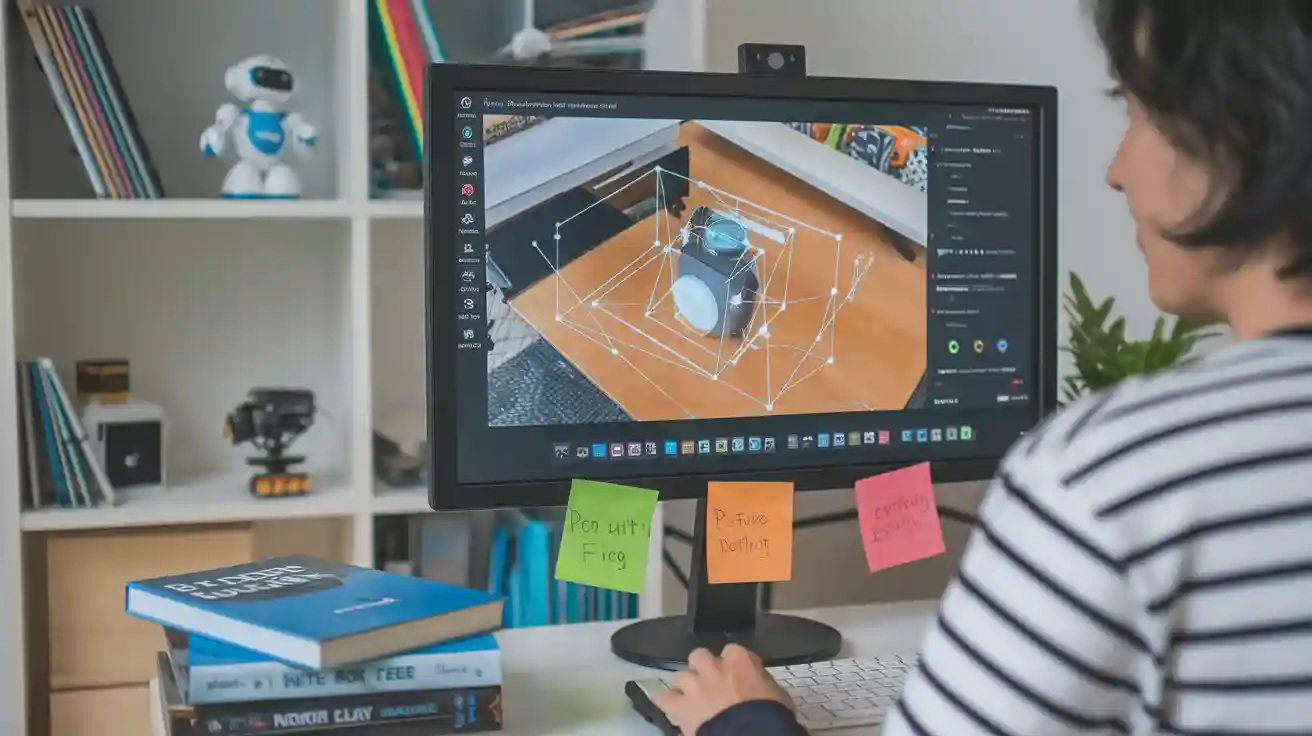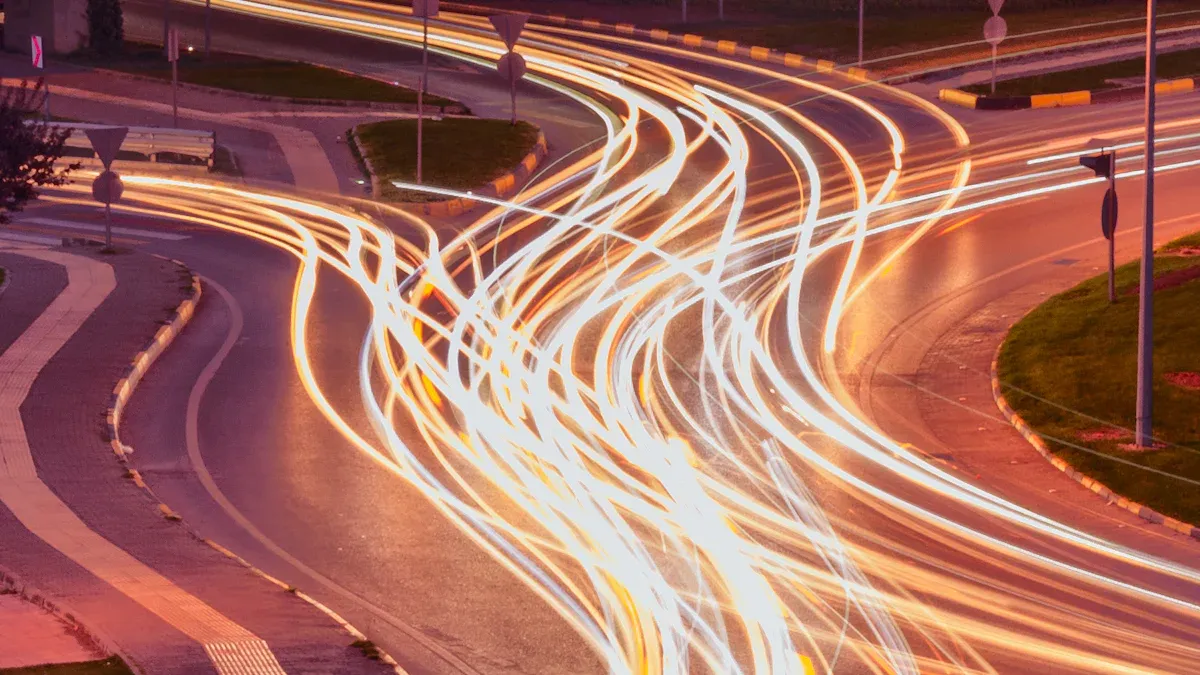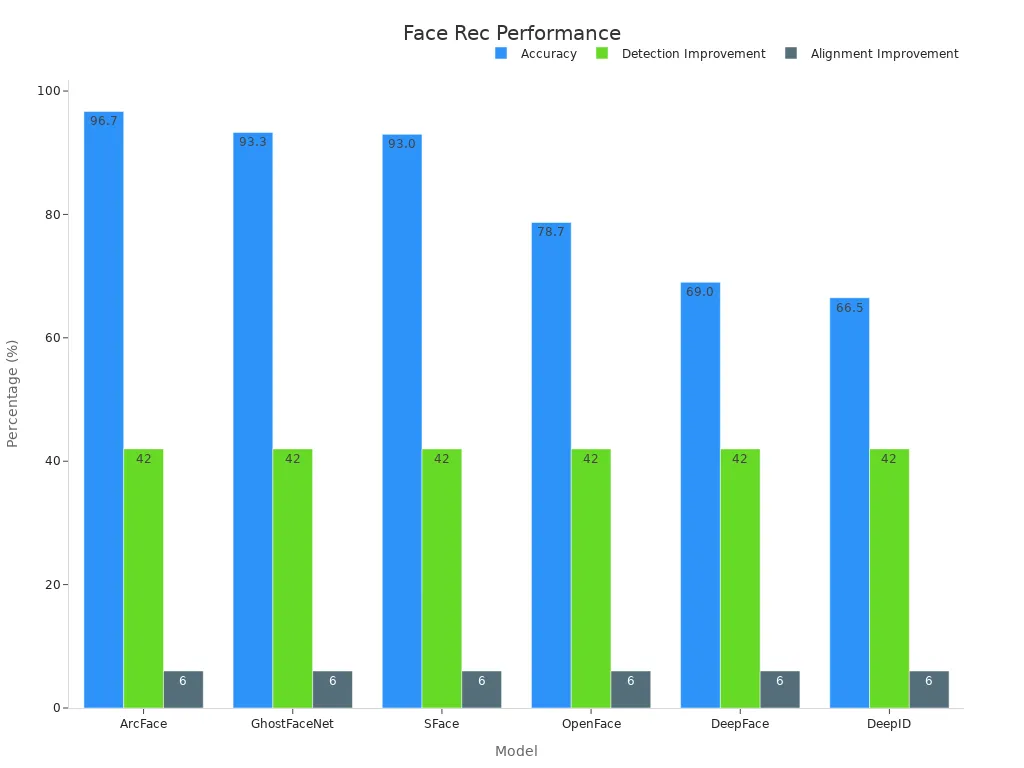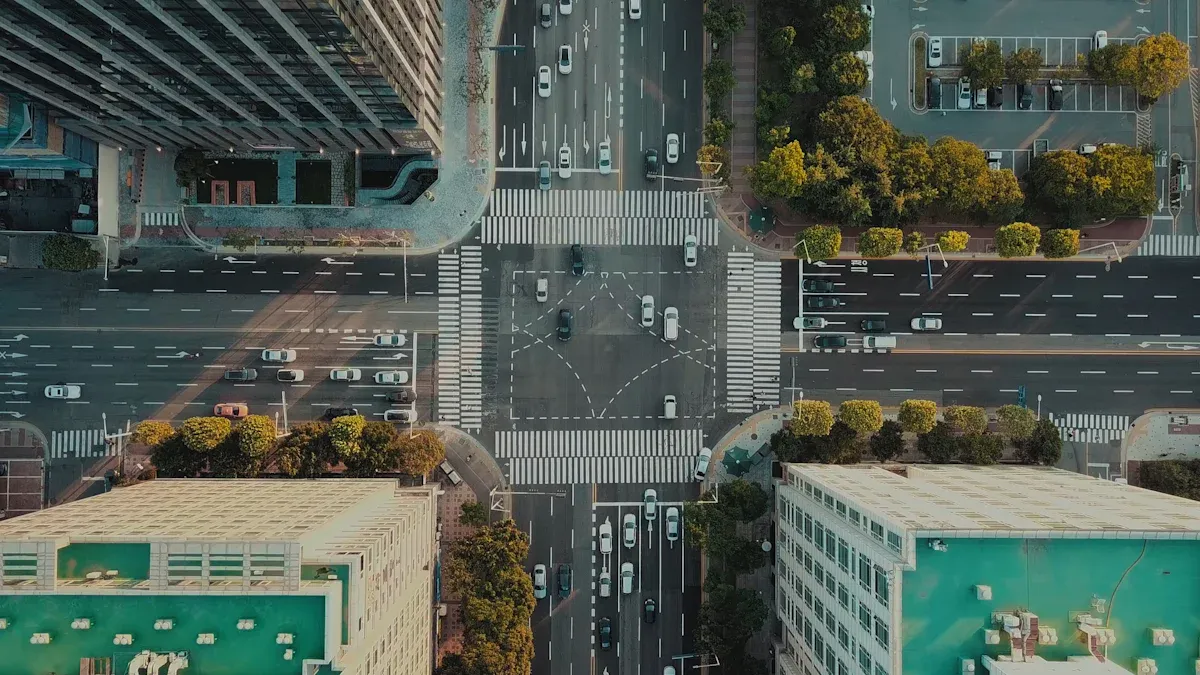OpenCV Machine Vision System for Beginners

OpenCV is a powerful open-source library designed for tasks in computer vision and image processing. It helps you analyze, manipulate, and interpret visual data from images and videos. Its simplicity makes it an excellent choice for beginners exploring the OpenCV machine vision system.
This library plays a crucial role in machine vision by enabling systems to "see" and make decisions based on visual inputs. OpenCV’s popularity speaks for itself: over 47,000 users form its community, and its downloads exceed 18 million. These numbers highlight its widespread use in fields like robotics, healthcare, and augmented reality.
Whether you're working with image filtering or building real-time applications, OpenCV provides the tools to bring your ideas to life.
Key Takeaways
- OpenCV is free software that makes working with images easier.
- It can do many things, like editing pictures or finding objects.
- Being part of the OpenCV group gives you tips and help.
- Begin with easy tasks like fixing images or finding faces.
- Keep practicing and trying new tools to get really good at it.
What is OpenCV?
Definition and Purpose
OpenCV, short for Open Source Computer Vision Library, is a powerful toolkit designed to help you work with images and videos. It provides a wide range of tools for tasks like image processing, object detection, and video analysis. Whether you want to enhance an image, detect objects in a video, or stitch multiple images together, OpenCV has you covered.
This library is widely used in computer vision and machine learning projects. For example, it includes algorithms for background subtraction, such as MOG2 and KNN, which are evaluated using metrics like precision and recall. These tools allow you to analyze visual data with accuracy and efficiency. OpenCV also supports advanced tasks like image stitching, where it matches features and estimates homography to create seamless panoramas.
What makes OpenCV stand out is its versatility. You can use it for simple tasks like resizing an image or complex ones like real-time object tracking. Its open-source nature means you can access it for free and customize it to suit your needs. This flexibility has made OpenCV a go-to choice for developers and researchers worldwide.
Role in Machine Vision Systems
In machine vision systems, OpenCV plays a crucial role by enabling computers to "see" and interpret visual data. These systems rely on OpenCV to process images and make decisions based on what they observe. For instance, in robotics, OpenCV helps robots detect and track objects. In healthcare, it powers facial recognition systems used for patient monitoring. Security systems use OpenCV for surveillance and threat detection, while the entertainment industry leverages it for augmented reality and gaming.
OpenCV's capabilities extend beyond these examples. It is widely recognized for its applications in image preprocessing, segmentation, face detection, and augmented reality. For instance, you can use it to align and estimate face poses, which is essential for tasks like emotion recognition. OpenCV also supports navigation and tracking, making it a valuable tool for autonomous vehicles and drones.
The library's integration with other tools further enhances its role in machine vision. For example, it works seamlessly with MATLAB’s Computer Vision System Toolbox, showcasing its adaptability. OpenCV has even been used in an iPad application to optimize sales representatives' performance in the field. These real-world applications highlight the importance of OpenCV in solving practical problems.
By using OpenCV, you can build machine vision systems that are efficient, accurate, and versatile. Its wide range of features and strong community support make it an excellent choice for beginners and experts alike.
Why Use OpenCV for Machine Vision?
Open-Source and Free to Use
OpenCV stands out because it is open-source and free for everyone. You can download it without any cost, making it accessible to students, hobbyists, and professionals alike. With over 47,000 users and an estimated 14 million downloads, OpenCV has become a trusted tool in the world of computer vision. Its open-source nature allows you to explore its code, customize it for your projects, and contribute to its development. This flexibility ensures that you can adapt OpenCV to meet your specific needs, whether you are working on an image processing task or a complex machine vision system.
Versatility and Performance
OpenCV excels in handling a wide range of computer vision tasks. Its versatility allows you to perform everything from basic image manipulation to advanced real-time object detection. For instance, OpenCV supports low-latency processing, which is essential for applications like autonomous vehicles and industrial automation. It also facilitates parallel processing, enabling you to analyze multiple video feeds simultaneously. These features make OpenCV a powerful choice for tasks requiring speed and precision.
Performance benchmarks highlight OpenCV’s strengths. It delivers high accuracy and precision in object detection tasks, ensuring reliable results. Metrics like recall and F1 score demonstrate its ability to handle imbalanced datasets effectively. Additionally, OpenCV maintains robustness and scalability, allowing it to perform well under varying conditions. Whether you are enhancing an image or building a real-time application, OpenCV ensures efficiency and reliability.
Large Community Support
When you use OpenCV, you join a large and active community. This community provides valuable resources, including tutorials, forums, and code examples. OpenCV’s developers aim to make each version better than the last, with the upcoming version 5 expected to have the highest community participation yet. Crowdfunding campaigns also support its growth, ensuring the library remains sustainable and resilient.
The strong community backing means you can find help easily when you face challenges. Whether you are troubleshooting an image processing issue or exploring new computer vision techniques, the community offers guidance. This collaborative environment makes OpenCV an excellent choice for beginners and experts alike.
Getting Started with OpenCV
Downloading and Installing OpenCV
To begin your journey with OpenCV, you first need to download and install it. OpenCV is available for multiple platforms, including Windows, macOS, and Linux. Follow these steps to get started:
- Visit the Official Website: Go to the OpenCV website and navigate to the "Releases" section. Here, you can find the latest version of OpenCV.
- Choose Your Platform: Select the appropriate version for your operating system. For most users, the pre-built binaries are the easiest option.
- Download the Files: Click the download link and save the files to your computer.
- Install OpenCV: Follow the installation instructions provided on the website. For Windows, you may need to extract the files and set up environment variables. On macOS and Linux, you can use package managers like Homebrew or apt-get for a smoother installation process.
If you prefer using Python, you can install OpenCV directly through pip. Open your terminal or command prompt and type:
pip install opencv-python
pip install opencv-python-headless
These commands will install the core OpenCV library and a lightweight version for headless environments. Once installed, you’re ready to start exploring OpenCV’s capabilities.
Tip: Always ensure you have the latest version of OpenCV to access new features and improvements.
Setting Up OpenCV in Python
After installing OpenCV, you need to set it up in Python. Python is one of the most popular programming languages for image processing, and OpenCV integrates seamlessly with it.
-
Verify Installation: Open a Python interpreter or IDE (like Jupyter Notebook or PyCharm) and type the following code to confirm OpenCV is installed:
import cv2 print(cv2.__version__)If the version number appears, your installation was successful.
-
Load an Image: To test OpenCV, load an image and display it using the following code:
import cv2 image = cv2.imread('example.jpg') # Replace 'example.jpg' with your image file cv2.imshow('Image', image) cv2.waitKey(0) cv2.destroyAllWindows()This script reads an image file and opens it in a new window.
-
Explore Basic Functions: Start experimenting with basic image processing tasks. For example, you can convert an image to grayscale:
gray_image = cv2.cvtColor(image, cv2.COLOR_BGR2GRAY) cv2.imshow('Grayscale Image', gray_image) cv2.waitKey(0) cv2.destroyAllWindows()
By setting up OpenCV in Python, you unlock the ability to perform a wide range of image processing tasks, from simple manipulations to advanced computer vision applications.
Note: Ensure you have the required dependencies, such as NumPy, installed. You can install it using
pip install numpy.
Beginner Resources and Tutorials
Learning OpenCV can feel overwhelming at first, but plenty of beginner-friendly resources are available to guide you. Here are some excellent starting points:
- Official Documentation: The OpenCV documentation provides detailed explanations and examples for every function. It’s a must-have resource for understanding the library.
- Online Tutorials: Websites like PyImageSearch offer step-by-step tutorials on image processing and computer vision projects.
- YouTube Channels: Channels like "Tech With Tim" and "Computerphile" feature video tutorials that explain OpenCV concepts in an easy-to-follow manner.
- Books: Consider reading books like Learning OpenCV 4 Computer Vision with Python by Joseph Howse. These books provide structured learning paths for beginners.
- Community Forums: Join forums like the OpenCV Q&A Forum or Reddit’s r/computervision. These platforms allow you to ask questions, share ideas, and learn from others.
Pro Tip: Start with small projects, like applying filters to an image or detecting edges. Gradually move on to more complex tasks as you gain confidence.
By leveraging these resources, you can build a strong foundation in OpenCV and image processing. Consistent practice and exploration will help you master this powerful library.
Basic Features and Capabilities

Image Processing Tasks
OpenCV excels in performing a wide range of image processing tasks. You can use it to manipulate images in various ways, such as resizing, cropping, and rotating. It also supports advanced operations like edge detection, color space conversion, and histogram equalization. These tools allow you to enhance image quality and extract meaningful information.
For example, OpenCV’s cvtColor function enables you to convert images between different color spaces, such as RGB to grayscale. This is useful for simplifying image data before further analysis. The library also supports parallel processing, which speeds up tasks like debayering and scaling. Below is a table showcasing OpenCV's performance in these operations:
| Operation | FPS (24 cores) | FPS (12 cores) |
|---|---|---|
| cvtColor (Debayering) | 480 | 400 |
| convertScaleAbs | 127 | 127 |
| Parallel (Debayering + Scaling) | 270 | 300 |
These metrics highlight OpenCV's efficiency in handling image processing tasks, even on systems with fewer cores. By leveraging these capabilities, you can process images quickly and effectively.
Object Detection and Tracking
Object detection and tracking are among OpenCV's most powerful features. You can use it to identify and follow objects in images or videos. For instance, OpenCV provides pre-trained models for detecting faces, eyes, and other objects. These models use techniques like Haar cascades and deep learning-based methods, making detection both accurate and efficient.
Tracking objects in real-time is another area where OpenCV shines. You can implement algorithms like KCF (Kernelized Correlation Filters) or CSRT (Discriminative Correlation Filter with Channel and Spatial Reliability) to follow objects as they move. This is particularly useful in applications like surveillance, robotics, and sports analytics. OpenCV's ability to combine detection and tracking ensures seamless performance in dynamic environments.
Real-Time Processing
Real-time image processing is a critical requirement for many modern applications, and OpenCV delivers exceptional performance in this area. Whether you're working on video streaming, augmented reality, or autonomous systems, OpenCV ensures low-latency processing. Its optimized algorithms allow you to analyze frames as they are captured, enabling real-time decision-making.
For example, OpenCV achieves frame rates of up to 18 FPS with the V4L2 backend, ensuring smooth performance with low latency. Here are some key frame rate and latency metrics for different implementations:
- Python: 10 FPS with latency between 400–1000 ms.
- Optimized Python: 4 FPS with high latency.
- V4L2 Backend: 18 FPS with low latency.
- High-speed setups: Over 500 FPS with low latency.
For immersive experiences like gaming or high-speed photography, frame rates of 60 FPS or more are ideal. OpenCV's ability to handle such demanding requirements makes it a top choice for real-time applications.
By mastering these features, you can unlock the full potential of OpenCV for real-time image processing, object detection, and other advanced tasks.
Applications of OpenCV in Machine Vision
Face Recognition and Gesture Detection
OpenCV offers powerful tools for face recognition and gesture detection, making it a cornerstone of modern machine vision applications. You can use OpenCV to identify faces in images or videos and match them with database entries for authentication or security purposes. Its algorithms, such as Haar cascades and deep learning-based models, ensure high accuracy and efficiency. Gesture detection adds another layer of interactivity, enabling systems to interpret hand movements or facial expressions.
Performance metrics validate OpenCV's effectiveness in face recognition tasks. Models like ArcFace achieve an impressive accuracy of 96.7%, with significant improvements from detection and alignment processes. Below is a table showcasing the accuracy and enhancements across different models:
| Model | Accuracy (%) | Improvement from Detection (%) | Improvement from Alignment (%) |
|---|---|---|---|
| ArcFace | 96.7 | 42 | 6 |
| GhostFaceNet | 93.3 | 42 | 6 |
| SFace | 93.0 | 42 | 6 |
| OpenFace | 78.7 | 42 | 6 |
| DeepFace | 69.0 | 42 | 6 |
| DeepID | 66.5 | 42 | 6 |

These capabilities make OpenCV a reliable choice for applications in security, healthcare, and gaming.
Industrial Automation
OpenCV plays a vital role in industrial automation by improving efficiency and reducing errors. You can use it to monitor production lines, detect defects, and ensure quality control. For example, a leading car manufacturer reduced paint defects by 30% using OpenCV-based automation. In food processing, OpenCV helps maintain hygiene compliance and minimizes contamination risks. Electronics manufacturers rely on OpenCV to identify faulty components, enhancing product reliability and reducing returns.
Its ability to process images in real-time makes OpenCV ideal for high-speed production environments. By integrating OpenCV into your automation systems, you can achieve better accuracy and streamline operations.
Augmented Reality
Augmented reality (AR) applications benefit greatly from OpenCV's advanced features. You can use OpenCV for camera calibration, which helps interpret images accurately by understanding the camera's unique characteristics. Pose estimation determines the position and orientation of 3D objects relative to the camera, ensuring seamless integration of virtual elements into real-world scenes.
Object tracking is another essential feature for AR. OpenCV's algorithms allow you to track objects in video feeds, maintaining interaction between virtual and physical elements. Rendering virtual objects becomes more realistic with OpenCV's ability to detect surfaces and estimate poses accurately. These features make OpenCV indispensable for AR applications in gaming, education, and marketing.
By leveraging OpenCV, you can create immersive AR experiences that blend the virtual and physical worlds effectively.
Beginner-Friendly Project Ideas

Image Filtering and Enhancement
Image filtering and enhancement are excellent starting points for learning OpenCV. These projects allow you to improve the quality of images by applying filters and adjustments. For example, you can use OpenCV to sharpen blurry images, reduce noise, or enhance contrast. These techniques are widely used in photography, medical imaging, and even satellite imagery.
The effectiveness of image enhancement can be measured through metrics like accuracy and mean improvement. For instance, applying enhancement techniques can increase accuracy from 70% to 85%, as shown in the table below:
| Metric | Before Enhancement | After Enhancement | Improvement |
|---|---|---|---|
| Accuracy (example) | 70% | 85% | 15% |
| Mean (ImageNet & COCO2017) | [value] | [value] | [value] |
These figures highlight the significant improvements you can achieve with basic filtering techniques. Start by experimenting with OpenCV functions like cv2.GaussianBlur or cv2.equalizeHist to see how they affect image quality.
Tip: Use side-by-side comparisons of the original and enhanced images to visualize the impact of your filters.
Simple Object Detection
Simple object detection projects introduce you to identifying objects in images or videos. OpenCV provides pre-trained models that can detect common objects like cars, people, and traffic lights. These models are easy to use and deliver fair accuracy, making them ideal for beginners.
The average accuracy of these models exceeds 60%, which is sufficient for basic tasks. You can also detect multiple objects in a single frame, enabling you to explore object tracking. For example, you can track a car's movement across a video feed or identify pedestrians in a crowded street.
To get started, use OpenCV's cv2.CascadeClassifier or deep learning-based methods like YOLO. These tools simplify the process of detecting and tracking objects, helping you build confidence in your skills.
Pro Tip: Test your object detection model on different datasets to understand its strengths and limitations.
Basic Face Detection System
Face detection is one of the most popular beginner projects in OpenCV. It involves identifying faces in images or videos, which is a fundamental step in applications like security systems and photo editing software. OpenCV's Haar cascades and deep learning models make this task straightforward.
Face detection systems built with OpenCV have shown impressive reliability. Research indicates an average success rate of 92.7%, with cursor activation accuracy reaching 95.8%. These results demonstrate the effectiveness of OpenCV for face detection tasks.
You can start by loading a pre-trained Haar cascade model and applying it to an image. Experiment with different parameters to optimize detection accuracy. As you gain experience, try integrating face tracking to follow faces in real-time video feeds.
Note: Always test your system on diverse datasets to ensure it performs well under various conditions.
Tips for Learning OpenCV
Explore Documentation and Tutorials
Official documentation and tutorials are essential for mastering OpenCV. They provide clear explanations and examples for every function, helping you understand how to use the library effectively. Tutorials guide you through practical projects, making it easier to apply concepts in real-world scenarios.
Learning OpenCV has become much simpler over time. Improved documentation and tutorials have made the library more accessible. Previously, navigating OpenCV’s resources was challenging due to incomplete guides. Today, you can find well-structured materials that simplify the learning process.
| Evidence Type | Description |
|---|---|
| Importance of Resources | Engaging with official documentation and tutorials leads to a better understanding of OpenCV. |
| Evolution of Learning | Learning OpenCV has become significantly easier due to improved documentation and tutorials. |
| Historical Context | Previously, learning OpenCV was challenging due to hard-to-navigate documentation and incomplete tutorials. |
Start by exploring OpenCV’s official website. It offers detailed documentation and links to tutorials. Websites like PyImageSearch also provide step-by-step guides for beginners. These resources will help you build a strong foundation in image processing and computer vision.
Join Online Communities
Joining online communities connects you with others who share your interest in OpenCV. Platforms like Reddit’s r/computervision and the OpenCV Q&A Forum allow you to ask questions, share ideas, and learn from experienced developers.
Active participation in these communities accelerates your learning. You can find solutions to common problems, discover new techniques, and stay updated on the latest advancements. Many members share code snippets and project ideas, which can inspire your own work.
When you face challenges, these communities provide valuable support. Whether you’re troubleshooting an error or exploring advanced features, you’ll find guidance from people who have overcome similar obstacles.
Practice Incremental Projects
Incremental projects are the best way to learn OpenCV. Start with simple tasks like applying filters to an image or detecting edges. These projects help you understand basic functions and build confidence.
As you progress, take on more complex challenges. For example, you can create a face detection system or track objects in a video feed. Each project adds to your skills and prepares you for advanced applications.
Break larger projects into smaller steps. Focus on one feature at a time, such as loading an image or converting it to grayscale. This approach makes learning manageable and ensures steady progress.
Tip: Save your code and document your learning process. Reviewing your work helps you identify areas for improvement and track your growth.
OpenCV offers numerous advantages for building machine vision systems, especially for beginners. Its user-friendly Python interface simplifies learning, while extensive documentation and examples make it easy to get started. You can explore a wide range of functionalities, from basic image processing to advanced real-time applications. OpenCV’s cross-platform support and built-in tools for machine learning models further enhance its versatility.
To succeed, start with beginner-friendly projects like face detection or image filtering. Consistent practice will help you master the library’s features. Engaging with the OpenCV community can also boost your confidence and skills. Studies show that community support improves self-efficacy and fosters better learning outcomes. By combining practice with collaboration, you can unlock the full potential of OpenCV.
Tip: Take advantage of OpenCV’s real-time performance to experiment with live object detection and other interactive applications.
FAQ
What programming languages does OpenCV support?
OpenCV supports multiple programming languages, including Python, C++, Java, and MATLAB. Python is the most popular choice for beginners due to its simplicity and extensive libraries. You can also use OpenCV with JavaScript for web-based applications.
Tip: Start with Python if you're new to programming. It’s beginner-friendly and well-documented.
Can OpenCV process videos in real-time?
Yes, OpenCV can process videos in real-time. It uses optimized algorithms to analyze video frames as they are captured. This makes it ideal for applications like surveillance, augmented reality, and robotics.
import cv2
cap = cv2.VideoCapture(0) # Access webcam
while True:
ret, frame = cap.read()
cv2.imshow('Video', frame)
if cv2.waitKey(1) & 0xFF == ord('q'):
break
cap.release()
cv2.destroyAllWindows()
Is OpenCV suitable for absolute beginners?
Absolutely! OpenCV is beginner-friendly. Its extensive documentation, tutorials, and community support make it easy to learn. You can start with simple tasks like image filtering and gradually explore advanced features like object detection.
Note: Focus on small projects to build confidence and understanding.
Do I need a powerful computer to use OpenCV?
No, you don’t need a high-end computer for basic OpenCV tasks. Most laptops can handle image processing and simple object detection. However, advanced tasks like deep learning-based object detection may require a GPU for faster performance.
Where can I find datasets for OpenCV projects?
You can find datasets on platforms like Kaggle, ImageNet, and OpenCV’s GitHub repository. These datasets cover a wide range of topics, from facial recognition to object detection.
Pro Tip: Start with small datasets to practice and gradually move to larger ones as you gain experience.
See Also
Understanding Cameras Used in Machine Vision Applications
Exploring Computer Vision Models for Machine Vision Systems
An Overview of Image Processing in Vision Systems
